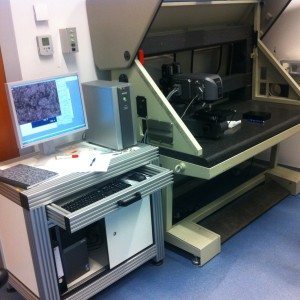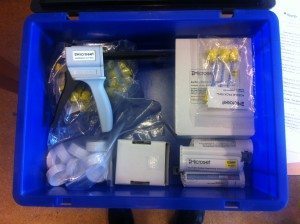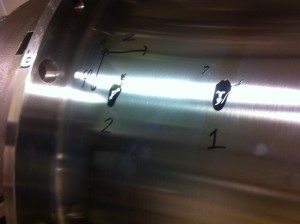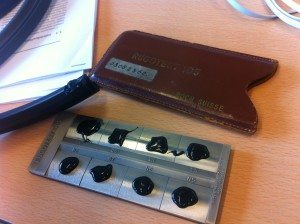Industrial Engineer with focus on Tribology and Sealing Technology. Team player with an open-minded mentality author of several scientific publications and an industrial patent. Interested in Lean Management, Innovation, Circular Economy, Additive Manufacturing and Connected Objects Technology.
Surface Replication Compounds
Table of Contents
The first challenge when measuring a surface topography via optical techniques is getting the sample to the lab. Although optical surface roughness measurement does not damage the component per se (NDT), the fact of fitting it into a microscope generally requires the destruction of the original component. The surface replication compounds solve this issue.

The surface replication technique has been used in aerospace, industrial and nuclear applications for many years, particularly for in-situ high resolution metallography. The replica technique allows reproducing a mirrored topography of a surface into a reduced dimensions polymeric sample. This technique also allows taking measurements on the exact same spot before and after running so the surfaces can accurately be compared afterwards. This is extremely useful when assessing wear phenomena.
Surface Replication Kit
Surface replication compounds suppliers generally provide a kit to obtain surface replicas with the following instruments:
- Dispensing pistol
- Compound cartridge
- Several disposable mixing nozzles

The cartridge is mounted on the dispensing pistol and the mixing nozzle is attached to the other end of the cartridge. The trigger of the pistol mechanically pushes the plunger of the cartridge squeezing out the replication compound into the mixing nozzle. The compound flows through the nozzle until its released to ambient over the desired surface.
Working Principle
The idea behind is quite simple:
- The fast-curing viscous polymer is applied on the desired surface.
- Once the replication compound is dry, it is carefully peeled off from the original surface. The original component surface roughness is captured on the polymer surface without damaging it.
- The high-resolution elastomeric replica of the surface can be easily studied in the lab afterwards.
The cartridge contains a specially formulated two-part silicon rubber. When these semi-viscous liquids are pushed out of the cartridge and mixed in the nozzle its curing begins. The compound must be pushed through the nozzle and applied on the surfaces before it solidifies. Since the two polymers are not mixed until reaching the nozzle those are kept inside the cartridge without risk of vulcanization.

The particularly-shaped nozzle is used to properly mix the polymers so the compounds begin to vulcanize in it. Because of that the mixing nozzle is disposable and needs to be replaced for every set of measurements. It is then advised to previously prepare all the surfaces for measurement so the compound can be applied to all of them using a single nozzle.
Surface Preparation before applying the Replication Compound
It is recommended to previously clean and dry the surfaces to measure. This way the compound will output its best results. The selection of the cleaning solvent will depend on the original surface characteristics. The silicon compounds is highly inert, it is suggested to contact the compound manufacturer when using a special cleaning solvent.
Difference between Replication Compounds
There is a wide range of replication compounds available specially tailored to the surface and environment characteristics. The temperature at which the compound is applied, for example, plays an important role since this will directly impact the curing time of the polymer.
The different compounds mainly approach the following issues:
- Viscosity: A higher viscosity fluid is needed when measuring on a tilted surface or when facing a strong gas flow; otherwise the compound will not be kept on the desired surface. If it is intended to measure cracks, fractures or micro-channels a low viscosity compound is preferable.
- Curing Time: The time the replication compound requires to solidify will depend on the specific compound in use and the application temperature. There are compounds with different curing velocities to facilitate its use at different temperatures. The curing time ranges from 2 to 60 minutes.
- Colors: A different coloring eases its sampling, collection and measurement.
- Special types: Special compounds are developed which can be applied under a wide range of temperatures or even under water conditions for corrosion, wear or damage inspection.
Shape measurement using Replication Compounds
The replication compounds can be used in the micro and macro scales. Viscosity plays an important role when capturing the shape of a component. Replication compounds suppliers usually have special pastes for that. Highly viscous polymeric plastelines are available with the same working principle. No dispenser pistol or nozzle is generally needed for those. The mixing of the polymers and its application is manually done.
Replication Compounds Accuracy
The accuracy of such replicas is generally set to 0.1 µm by the product manufacturers. The author did a rough benchmark tests to check its accuracy under different surface roughness on metal surfaces. A confocal microscope and different lenses were used for the following measurements:
| Comparison Ra REFERENCE (Ra) – Ra REPLICA (Ra*) | ||||||
| Ra-Ra* (µm) | (Ra-Ra*)/Ra (%) | |||||
| 50X | 100X | 150X | 50X | 100X | 150X | |
| N2 | -0,286 | 0,036 | 0,03 | -325,0% | 34,0% | 40,0% |
| N3 | 0,136 | 0,03 | -0,017 | 53,5% | 22,4% | -12,4% |
| N6 | 0,18 | -0,033 | -0,023 | 29,6% | -6,2% | -6,1% |
| N7 | 0,351 | -0,0273 | 0,028 | 29,2% | -2,9% | 3,1% |
| AVERAGE | 0,09525 | 0,001425 | 0,0045 | -53,2% | 11,8% | 6,1% |
The results show a better accuracy than the one specified by the manufacturer. The so called “clear surface layer” is a translucent top surface film found in some replication compounds. This layer generates a certain ambiguity since it is not clear whether the microscope focuses on the top or the bottom of such layer. This phenomenon was not observed when doing this test.
A much accurate publication approaching this issue is found in this paper.
Cost of the Replication Kit and Compound Cartridges
The cost varies depending on the supplier and the volumes purchased. The following table shows some indicatives prices:
| Quantity | Item | Cost |
| 1 | 50 ml Manual dispensing gun | 100 € |
| 1 | 50ml Compound cartridge | 60 € |
| 10 | Mixing nozzle | 25 € |
Leave a Reply
You must be logged in to post a comment.


Nice comprehensive review! The confocal microscope worked well for the measurements?
Nice piece! Good to make people aware of this. As it is sometimes a forgotten technology. We use this almost on a daily basis to track the surface evolution of a surface in wear experiments. We came to the same conclusions when comparing the surface statistics. Next to that the absolute error between replica and real surface when subtracting the same areas was also very low.
Hi dude, Im quite loving writings on your blog. They are structured properly, easy to consume and understand, in spite of English being my 3rd language. Cheers.
Thanks..Short but explains many details…
Hello, yes silicone rubber replica are very useful for surface topography studies.
It can be used to study the surface roughness even when it is so large that no optical or stylus instrument can be used to study the roughness.
See the following reference about this:
https://link.springer.com/article/10.1007/s11249-018-1092-0
Hi guys, we have a requirement to preform a surface replication using the method explained in this thread, any suppliers suggestion, I’m based in united arab Emirates
Thank you Xavier!
The main advantage of using a replica of the ski-base surface instead of the ski base itself is the possibility of collecting samples during testing, eliminating the need to take the skis to the lab. (We use a Zygo NewView: https://www.zygo.com/products/metrology-systems/3d-optical-profilers/newview-9000 to acquire the topography of the replica)
I found this reference relevant in our case: https://doi.org/10.1088/2051-672X/4/3/035002
Cheers, Andreas